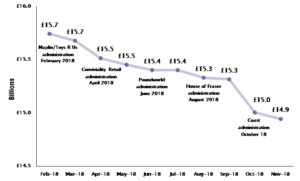UK bank lending to small and medium sized retail businesses has fallen by four per cent in the last year to £14.9 billion, as the sector has been hit by a string of bankruptcies.
However, according to online business finance comparison site Funding Options, smaller retailers are being penalised as banks worry over retailers’ abilities to deal with challenges facing the sector.
Yet banks are not cutting off lending to the retail sector overall. Lending to large retailers has risen by five per cent over the last year, to £37.7 billion in November 2018 from £36 billion the year before.
High streets are becoming gradually hollowed out as more big retailers shift their focus to growing online sales. One in 10 town centre shops now stand empty, according to the British Retail Consortium (BRC) and Springboard. Yet smaller retailers need additional funding to enhance their websites and improve their high-street offering in order to compete.
Smaller retailers are caught in a double bind as they find it tougher to get credit from suppliers, which creates extra pressure on cash flow, while traditional forms of lending becomes harder to access.
Insolvency Service data shows that insolvencies in the retail sector jumped by 13 per cent in the year to September 30 2018.
Funding Options says that more small businesses are being inventive when it comes to plugging the funding gap. Asset finance and peer-to-peer lending have increased by 12 per cent and 51 per cent respectively in the last year, according to a recent British Business Bank survey.
Conrad Ford, CEO of Funding Options, said: “Retailers struggling to get lending must not give up the ghost. There are other forms of finance other than bank loans.”
“Many small businesses have characteristics, such as seasonality, which can mean they have different risk profiles. Being a seasonal business can mean inconsistent income, and therefore cash flow, which can make it hard to maintain the regular loan repayments that are needed under a standard bank loan.”







